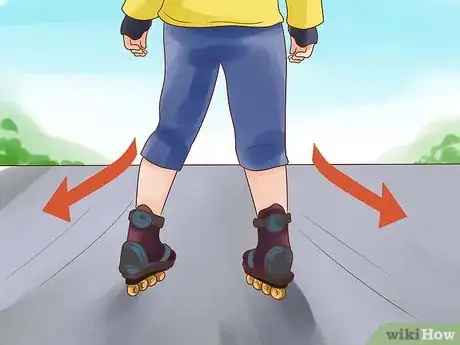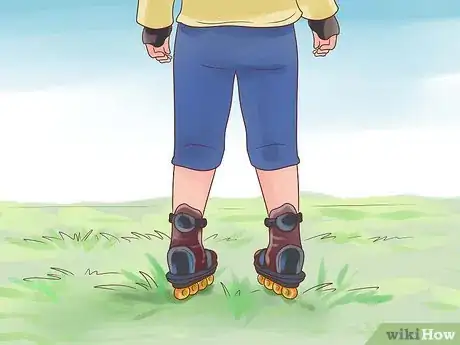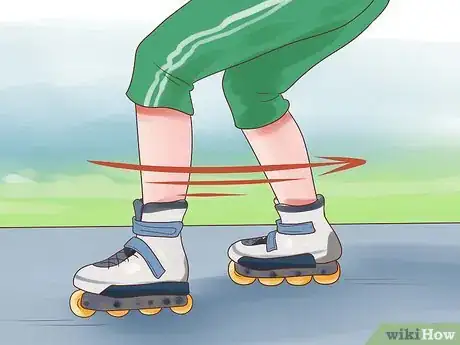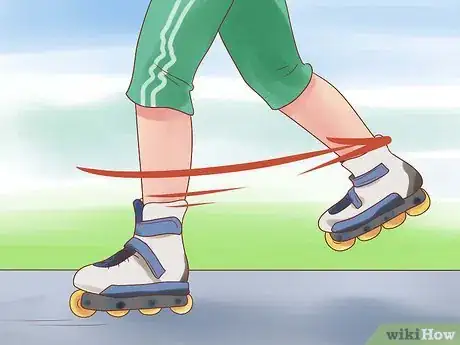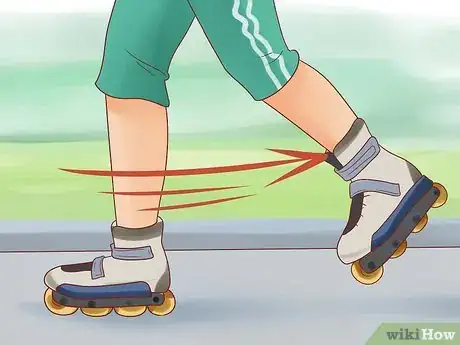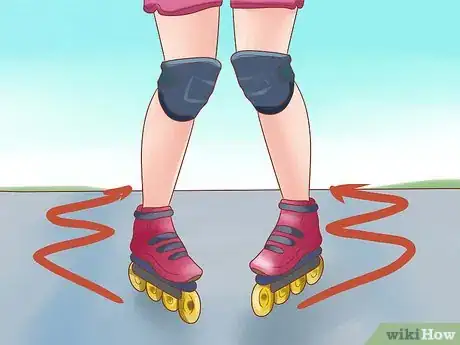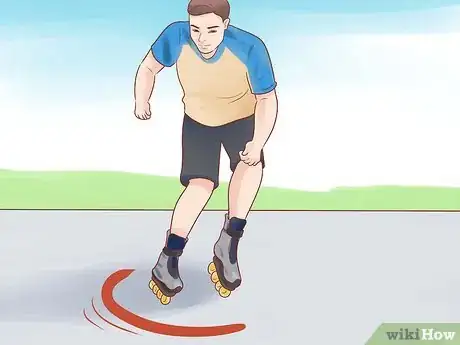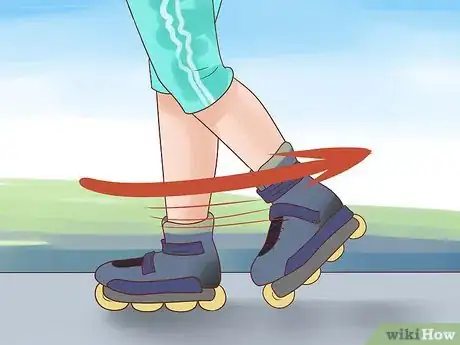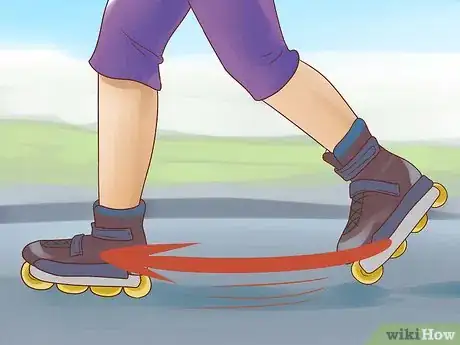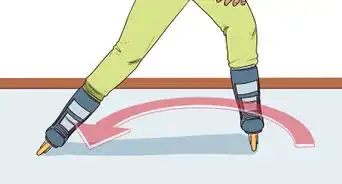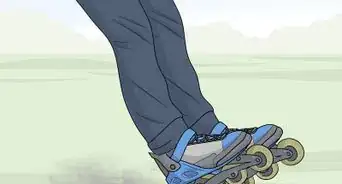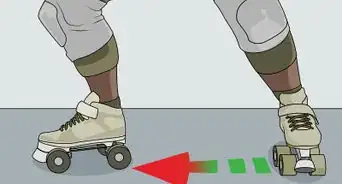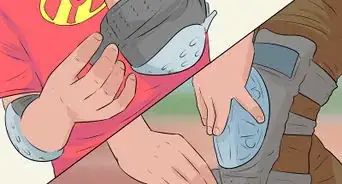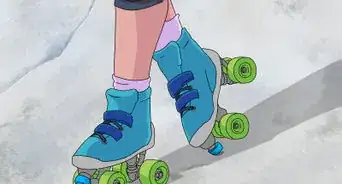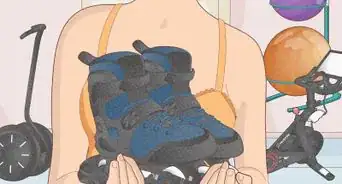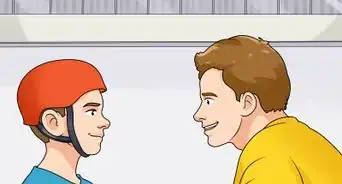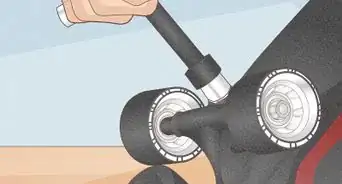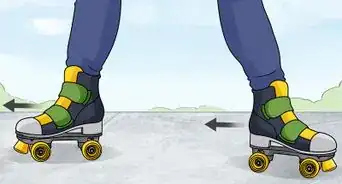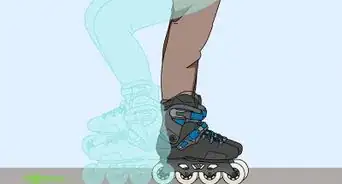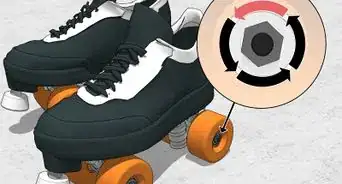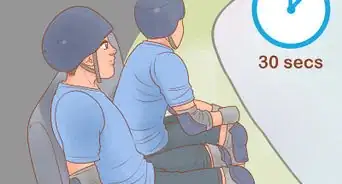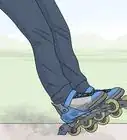X
wikiHow is a “wiki,” similar to Wikipedia, which means that many of our articles are co-written by multiple authors. To create this article, 15 people, some anonymous, worked to edit and improve it over time.
There are 8 references cited in this article, which can be found at the bottom of the page.
This article has been viewed 68,891 times.
Learn more...
Skating backwards is an aggressive move used in advanced inline skating. After mastering forwards rollerblading, you can make the transition to reverse skating. It can be a bit scary, but with a little practice, you can master it in no time.
Steps
Part 1
Part 1 of 2:
Learning the Basics
-
1Roll backwards. When first learning how to rollerblade backwards, the first step is getting comfortable with the backwards motion. Before trying to learn any specific moves, roll your body backwards on your skates. Push yourself backwards from a wall, fence, or other object.
- Start off rolling backwards on a flat surface. Then, as you feel more comfortable with the backwards motion, roll backwards down a small slope or hill.
- Make sure there is no debris in your way as you practice.
- Keep your skates on the ground. As you work on rolling backwards and going through your edging drills, do not lift your skates.[1]
-
2Practice on grass. Before you hit the concrete, get the feel for some basic movements, like edging, on grass or carpet. Start with your skates in an inverted V position, toes touching. The skates should be on the center edge. Push your feet back and out. This changes your skates to the inside edge. Finish the movement by pulling the feet back together into a V position, heels together, skates on the center edge. Push forward, following the same path until your skates are back in the original inverted V position, toes touching. You are making an egg-like shape with your feet.
- Practice rolling back and forth along the center and inside edges as you familiarize yourself with the feeling of edging.
- Pressure should remain on the arches of your feet. Make sure you do not widen your feet more than slightly beyond shoulder width.
- Edging is one of the fundamentals of inline skating. It refers to using the three edges of your wheel. "Center edge" refers to the part of the wheel used when the skates are upright and you stand straight. "Inside edge" refers to the part of the wheel being used when your skates are tipped inward, towards the center of the body.[2]
Advertisement -
3Roll with staggered feet. Another technique to practice before you begin reverse skating is rolling with staggered feet. Look over your dominant shoulder to see where you are going. Place the foot that corresponds to your dominant shoulder behind you. This should naturally stagger your feet. Push yourself backwards and roll.
- Staggering your feet will help you see where you are going and help you cover more area.
- If your dominant shoulder is your right shoulder, your right foot will be the one farthest back.
- Make sure your knees are bent. If they are straight, you will lose your balance.
-
4Glide on one foot. Practice rolling backwards like in the first step, but lift one foot off the ground. It does not have to be very far from the ground, just an inch or so. Your weight will have to be centered on the skate on the ground.[3]
- This helps you develop skills and confidence that will be needed when you start more advanced reverse skating techniques.
-
5Shift your weight from one foot to the other. Step out to the right, placing all your weight on that foot. The left foot should help you stay balanced. Then, step to the left, shifting all your weight over to the left foot. Practice going back and forth between your feet, getting used to the feel of your weight shifting between each skate. When you feel comfortable with this, start letting the heel on the foot with all your weight on it angle out slightly.[4]
-
6Get the posture right. Knees should be bent. The body should be kept upright. Starting position should be slightly less than shoulder width. The skates shouldn't be touching, but don't start wider than shoulder width.[5]
- Don't lean forward towards your feet while skating backwards. That could result in a fall on your face.
Advertisement
Part 2
Part 2 of 2:
Moving to More Advanced Backward Skating
-
1Skate with backward scissors. Start with your toes touching, feet angled outwards into a V shape. Push out to the side with your toe wheels; do not push backwards in a straight line.[6] When the feet are a little wider than shoulder width, start to bring them back together. When your heels almost touch, pivot your toes to push out, beginning a new scissor. While doing this movement, your feet will be skating in a figure 8 pattern.
- Don't go too wide with your scissors. This will stall your stride.
- Make sure you feel the pressure on your arches. This means you are balanced. If you move forward to try to balance, you will fall.
- A scissor is a skating move using both feet where the feet move outwards from a close position, then return together in an oval shape. Linked scissors look like figure 8s.
- This is building off the edging technique practiced in the grass.
-
2Skate with strokes. After you have mastered skating backward scissors, you can move to skating with strokes. Begin just like you were going to push out with your toes. Instead of going into a full scissor with both feet, push out sideways with only your left foot. This should result in an arc with your left leg, which is a half scissor. Your right foot should remain rolling backwards in a straight line. When you bring your left leg back in close to your right, shift your weight onto your left leg and push out with the toe of your right skate into a half scissor. The left foot should remain rolling in a straight line.[7]
- This step is achieved by skating with linked half scissors, similar to skating with linked scissors like in step 1.
- This step builds off the one foot gliding technique developed while you were learning the basics.
- Before you begin skating strokes, you may want to skate a few backward scissors to warm up.
-
3Skate with backward Cs. Start by shifting your weight back and forth between the skates. Make sure the heels of your weighted foot are angled out slightly. When you transfer the weight to the right skate, push off with the toe of your left skate as your bring the left skate off the ground slightly. Your weight will be on your right skate and you will now be rolling backwards. As you transfer the weight over to the left skate, turn your right foot, completing a C with your skate. Do the same thing for the other side.
- Practice making C strokes with each foot if you are struggling. Make a few Cs with your left foot, then switch to your right foot as you slowly move backwards on your skates. Remember, the Cs will be made with the foot with the weight on it.
- The arm on the weighted side will go back as your weighted foot makes a C, then come forward as the other arm goes back with the other weighted side.[8]
-
4Turn from forward to backward skating. As you are skating forwards, place your weight on your right leg. Lift the heel of your left skate, pivot with the weight on the toe of your left skate, and shift your skate to a heel to heel stance. You will be sideways instead of facing forward now. Shift the weight to your left skate and pivot with the weight on the toe of your right skate, making the skates parallel. You should now be skating backwards.[9]
-
5Turn from backward to forward skating. In the wide part of the scissor, look over your shoulder, shifting your hip. Lift your right foot, moving all your weight to your left foot. Bring your right foot around, placing it on the ground in a forward direction. Push off with your left foot, making you glide on your right foot. Drop your left foot parallel beside your right and begin skating forwards.[10]
Advertisement
Community Q&A
-
QuestionCan I ice skate backwards if I can rollerblade backwards?
 Community AnswerYes, but you still need to practice on the ice too. Try starting out with backward scissors and then do swizzles.
Community AnswerYes, but you still need to practice on the ice too. Try starting out with backward scissors and then do swizzles. -
QuestionIs there a way to skate backwards while holding items in my hands?
 Community AnswerYes, you can do anything with enough practice.
Community AnswerYes, you can do anything with enough practice. -
QuestionHow do I stop when rollerblading backwards?
 Community AnswerAs a beginner, you will want to slow down first. As you get down to a safe speed, you simply turn around. You will stop backwards skating and begin forwards skating. As you get more advanced, you can change over at higher speeds.
Community AnswerAs a beginner, you will want to slow down first. As you get down to a safe speed, you simply turn around. You will stop backwards skating and begin forwards skating. As you get more advanced, you can change over at higher speeds.
Advertisement
References
- ↑ http://www.skatefaq.com/skate.2.1.html#backwards
- ↑ http://www.getrolling.com/orbit/SkatersEdge.html
- ↑ http://www.skatefaq.com/skate.2.1.html#backwards
- ↑ https://www.youtube.com/watch?v=51HD8UPeO74
- ↑ http://www.skatefaq.com/skate.2.1.html#backwards
- ↑ http://www.getrolling.com/orbit/w067_masteringswizzles.htm
- ↑ http://www.getrolling.com/orbit/backwards.html
- ↑ https://www.youtube.com/watch?v=51HD8UPeO74
- ↑ http://www.getrolling.com/orbit/transitions.html
About This Article
Advertisement
